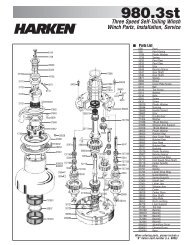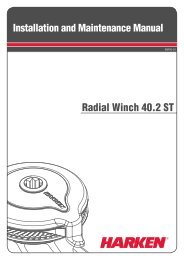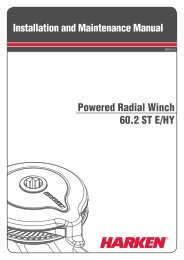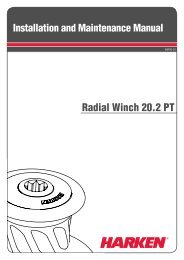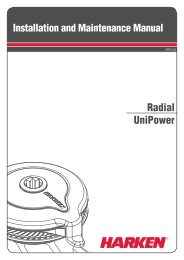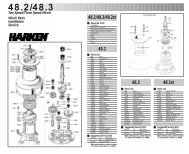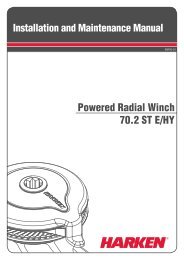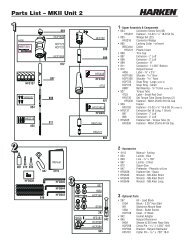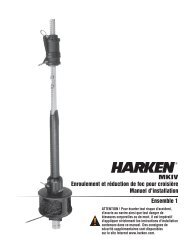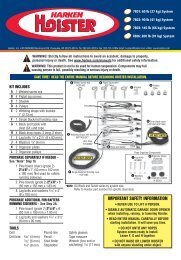Create successful ePaper yourself
Turn your PDF publications into a flip-book with our unique Google optimized e-Paper software.
Preassembly<br />
Cutting Headstay to Length • Reusing Existing Headstay<br />
■ Reusing Existing Headstay<br />
Your system is designed to allow use of your existing headstay.<br />
Examine your headstay to be sure it is in good condition before<br />
reusing. On wire headstays look for corrosion and cracks at<br />
swage fittings and end terminals. Check for abrasion or wire<br />
damage. On rod headstays check for corrosion or damage to<br />
the coldheaded ends and terminals as well as abrasion, nicks or<br />
kinks to the rod.<br />
Headstay condition will vary depending upon climate and use.<br />
As a rule do not reuse wire which has been in saltwater for more<br />
than four seasons, or wire which is more than 6 years old. Rods<br />
generally have a longer life than wire, but evaluate your rod carefully<br />
before reusing.<br />
■ Cutting Headstay to Length<br />
Before cutting headstay to length, be sure to determine pin-to-pin headstay length and write it on the outside back<br />
cover.<br />
To determine the cut point of a wire or rod, measure up from the lower measurement point of the headstay.<br />
■ Swage Studs<br />
Subtract 18 1 /4" (464 mm) from your pin-to-pin length and cut the wire at this point.<br />
Remember the old adage, "measure twice, cut once."<br />
When the headstay is shortened 18 1 /4" (464 mm) the turnbuckle will be one half to two thirds<br />
open, allowing adjustment of the headstay length.<br />
If necessary, you may shorten your headstay up to 20" (508 mm), but shortening a wire<br />
more than 18 1 /4" (464 mm) will limit headstay adjustment.<br />
Use only swage studs provided by <strong>Harken</strong> to insure that the length and threads are correct.<br />
Have the wire swaged by a reputable rigger. Improperly applied swage studs are prone to<br />
failure and bent or “banana” swages cause difficulty with furling.<br />
18 1 /4"<br />
(464 mm)<br />
Length Check: Check the length by slipping the swage stud on the wire. The distance from<br />
the center of the eye at the top of the wire to the end of the swage stud should be equal to<br />
the pin-to-pin headstay length less 9" (229 mm).<br />
Pin-to-pin headstay length less 9" (229 mm)<br />
Longueur d'axe à axe de l´étai moins 229 mm<br />
Vorstaglänge Bolzen-Bolzen-Mass abzüglich 229 mm<br />
Lunghezza perno-a-perno dello strallo diminuita di 229 mm<br />
March 2003 Unit 1 MKIII 9






